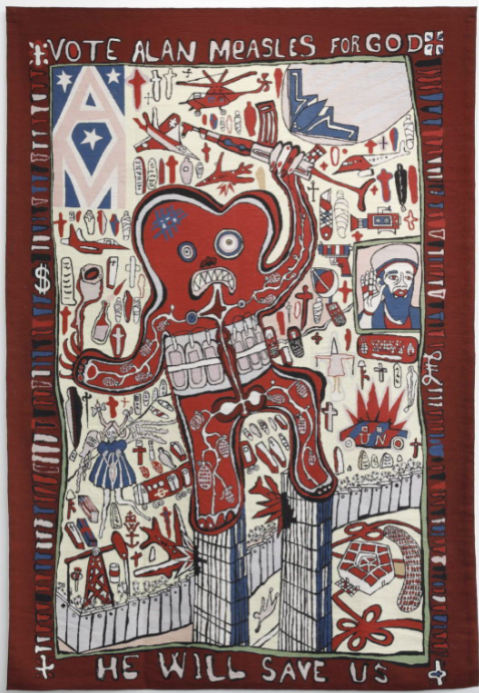Grayson Perry's Smash Hits at the Royal Scottish Academy
By Lucien Willey
Walking into the Royal Scottish Academy for their new exhibition of Sir Grayson Perry’s work Smash Hits, the first thing that will strike you is the monumental diversity of the pieces on display, as benefits the largest-ever show of the artist’s work. In the first room of the exhibition alone, you’re confronted in quick succession by an elaborate print described as “self-portrait as a fortified town”, a series of figurines that resemble historic relics of the sort you might see in an anthropological museum – at least until you see consumerist iconography draped all over them – and an Afghan-style rug that depicts a stylized teddy bear wearing a suicide vest and wielding a Kalashnikov, surrounded by the symbols and images of the war on terror, and accompanied by the phrase “VOTE ALAN MEASLES FOR GOD, HE WILL SAVE US” [Fig. 1]. And that’s just the first room; the amuse-bouche, if you will.
Figure 1: Grayson Perry, VOTE ALAN MEASLES FOR GOD, 2008, wool needlepoint tapestry, label, black felt-tip pen, 256 x 176 cm.
It would be remiss of any reviewer to try to place the varied works of this exhibition under a single theme, other than ‘society’ as viewed through the lenses of gender, sexuality, class, race, religion, and politics, especially how we combine them in our identities, done with a decidedly British slant. The comprehensiveness of the material, however, means that many of the insights on display, especially on the divisiveness of the internet age, and the nature of our identities, are applicable to just about anyone who has ever thought about themselves and who they are in any way whatsoever.
Perhaps the best examples of this theme of identities are the elaborate tapestries that make up a core component of the exhibition. In terms of sheer size, first among them is the Walthamstow Tapestry, a 15-meter long piece done in an almost medieval style themed around the seven ages of man, but interwoven with hundreds of brand names, as an exploration of the role that corporate branding plays in our lives.
In my opinion, however, the best among these tapestries is the The Vanity of Small Differences, a six-tapestry series loosely based on a A Rake’s Progress that explores the themes of class through the life of a fictional tech billionaire as he rises from a lower-middle-class blue collar family in the 70s through the university system, marries into an upper-middle class family, attains massive wealth through the tech boom, and finally dies in a car crash. This set is stuffed with symbolism and memorable images. The most striking of these, in my opinion, is The Upper Class at Bay [Fig. 2], which portrays the old English aristocracy as a tweedy, unsympathetic stag with a face that vaguely resembles Nigel Farage, pursued across its traditional estate by hounds as the estate's new masters – the entrepreneurial class – look on, and protesters of inequality appear around the edges.
Figure 2: Grayson Perry, The Upper Class at Bay, 2012, wool, cotton, acrylic, polyester and silk tapestry, 2 x 4 m, Victoria Miro Gallery, London.
Outside of the tapestries, the single most dramatic piece is the Tomb of the Unknown Craftsman [Fig. 3], an ancient-looking reliquary made for Perry’s 2011 exhibition at the British Museum. Made in the shape of ship, with a hull composed of replicas of pieces from the British Museum and its masts and yards bedecked with a variety of glass bottles and jars, filled to represent the blood and sweat of the unknown artists who are only remembered through the objects they made. This vessel is intended as a memorial to these artists, a ship which they can sail into the afterlife. The baroque austerity of this piece, which looks as though it could have been made in 2011 B.C. as easily as 2011 A.D. contrasts with the colourful, modern, commentary that makes up much of the rest of the exhibition. It is all the more powerful in its difference.
Figure 3: Grayson Perry, Tomb of the Unknown Craftsman, 2011, cast iron, oil paint, glass, rope, wood, flint hand axe, 305 x 204 x 79 cm, Collection Bonnefanten Museum, Maastricht.
To write even brief thoughts on every piece in this exhibition would take far more pages and ink than is reasonable, but you can rest assured that they are all worth seeing and contemplating. The exhibition's overall look at the nature of our identities and society, and how they are intertwined should, at least in some form, resonate with everyone, as we all have identities and live in modern society. So, if you have a free weekend this month, I’d highly advise you to go down to Edinburgh and check out Smash Hits. Budget about £10 for the entry fee (with student discount), a few hours of your time, and walk out of the Scottish National Academy with a new perspective, or at very least a few hours well-spent.



